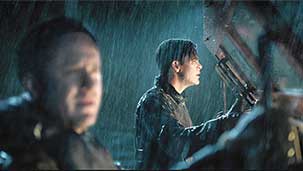Set medics are often seen as a precaution. On a good day, you shouldn’t have anything to do. Actors and stunt workers play their scenes and leave unscathed. You pack up your stethoscope and purple latex gloves and walk off into the sunset. But in The Finest Hours, you’re not just a precaution—you’re a necessity.
The Finest Hours is, for the most part, a disaster movie. It’s the true story of the heroic 1952 rescue of 32 seamen aboard the SS Pendleton, which was led by Bernie Webber and his ragtag crew. It was mission that has gone down in U.S. Coast Guard history as the single greatest small boat rescue ever attempted; a severe storm crippled the SS Pendleton, leaving the coast guards no choice but to brave aggressive waves that threatened to tear their 36-foot motorboat into pieces. Their chances of survival were slim to none.
To recreate this harrowing affair, you and the cast of The Finest Hours endured weeks of filming in what seems to have been a watery hell. Your days began and ended in a massive 800,000-gallon water tank, and the cast was drenched in ice-cold water while they acted out their scenes; a torrential downpour blasted from a fire-hose. That kind of exposure to cold temperatures can take a toll on the human body, and, as the set medic, it was your job to make sure nobody fell ill during the shoot. You had to be prepared with the proper equipment and ready to jump into action the moment the director yelled cut. If a pivotal performer got injured or fell sick, production would halt. I can imagine it was a very difficult task, especially with such a huge cast, so you could probably relate to the long odds and seemingly insurmountable task that the rescuers in the film faced.
I was impressed how director Craig Gillespie was able to capture the desperate strain on the protagonists’ faces. I certainly didn’t get the sense that the film’s stars, Chris Pine, Casey Affleck, Ben Foster, etc, were sitting back and relaxing while their stunt-doubles accepted all the on-screen punishment.
Not to say the stunt doubles didn’t have their own troubles. To mimic the ragdoll motions of bluejackets being tossed around in an oil tanker, The Finest Hours stunt team look like they were launching themselves against iron walls and metal grates. They weren’t being ravaged by the sea, but instead, the vessel itself. How often did they have to check in to the McPeake clinic over the course of shooting? More than a few times, I’ll bet.
As exhausting as this must have been for you and the rest of the cast and crew, the events depicted in The Finest Hours are riveting. It’s one of Hollywood’s more recent disaster-themed action-adventures that I’ve been able to enjoy. That speaks volumes when you take the large, CGI waves into consideration. Too much CGI has a tendency to strip away any real sense of danger—but not this time. The Finest Hours carefully balances CGI and authenticity to deliver a solid end product. The moment the first crack tears its way through the bow of the SS Pendleton’s reinforced walls, I was hooked.
And a lot of that was thanks to your presence on the set. You were able to create a safe environment in which the performers could push themselves to the limit and bring a striking realism to the screen. And for that, I thank you.
Sincerely,

Ankit







